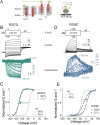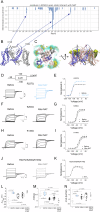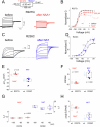Lipophilic compounds restore function to neurodevelopmental-associated KCNQ3 mutations
- PMID: 39300259
- PMCID: PMC11413209
- DOI: 10.1038/s42003-024-06873-4
Lipophilic compounds restore function to neurodevelopmental-associated KCNQ3 mutations
Abstract
A major driver of neuronal hyperexcitability is dysfunction of K+ channels, including voltage-gated KCNQ2/3 channels. Their hyperpolarized midpoint of activation and slow activation and deactivation kinetics produce a current that regulates membrane potential and impedes repetitive firing. Inherited mutations in KCNQ2 and KCNQ3 are linked to a wide spectrum of neurodevelopmental disorders (NDDs), ranging from benign familial neonatal seizures to severe epileptic encephalopathies and autism spectrum disorders. However, the impact of these variants on the molecular mechanisms underlying KCNQ3 channel function remains poorly understood and existing treatments have significant side effects. Here, we use voltage clamp fluorometry, molecular dynamic simulations, and electrophysiology to investigate NDD-associated variants in KCNQ3 channels. We identified two distinctive mechanisms by which loss- and gain-of function NDD-associated mutations in KCNQ3 affect channel gating: one directly affects S4 movement while the other changes S4-to-pore coupling. MD simulations and electrophysiology revealed that polyunsaturated fatty acids (PUFAs) primarily target the voltage-sensing domain in its activated conformation and form a weaker interaction with the channel's pore. Consistently, two such compounds yielded partial and complete functional restoration in R227Q- and R236C-containing channels, respectively. Our results reveal the potential of PUFAs to be developed into therapies for diverse KCNQ3-based channelopathies.
© 2024. The Author(s).
Conflict of interest statement
Yun Lyna Luo is an Editorial Board Member for Communications Biology, but was not involved in the editorial review of, nor the decision to publish this article.
Figures






References
-
- Hille B. Ion Channels of Excitable Membranes. 3rd ed. Sunderland, MA: Sinauer Associates, INC; 2001.
-
- Jespersen, T., Grunnet, M. & Olesen, S. P. The KCNQ1 potassium channel: from gene to physiological function. Physiology20, 408–416 (2005). - PubMed
-
- Jentsch, T. J. Neuronal KCNQ potassium channels: physiology and role in disease. Nat. Rev. Neurosci.1, 21–30 (2000). - PubMed
-
- Brown, D. A. & Adams, P. R. Muscarinic suppression of a novel voltage-sensitive K+ current in a vertebrate neurone. Nature283, 673–676 (1980). - PubMed
Publication types
MeSH terms
Substances
Grants and funding
LinkOut - more resources
Full Text Sources

